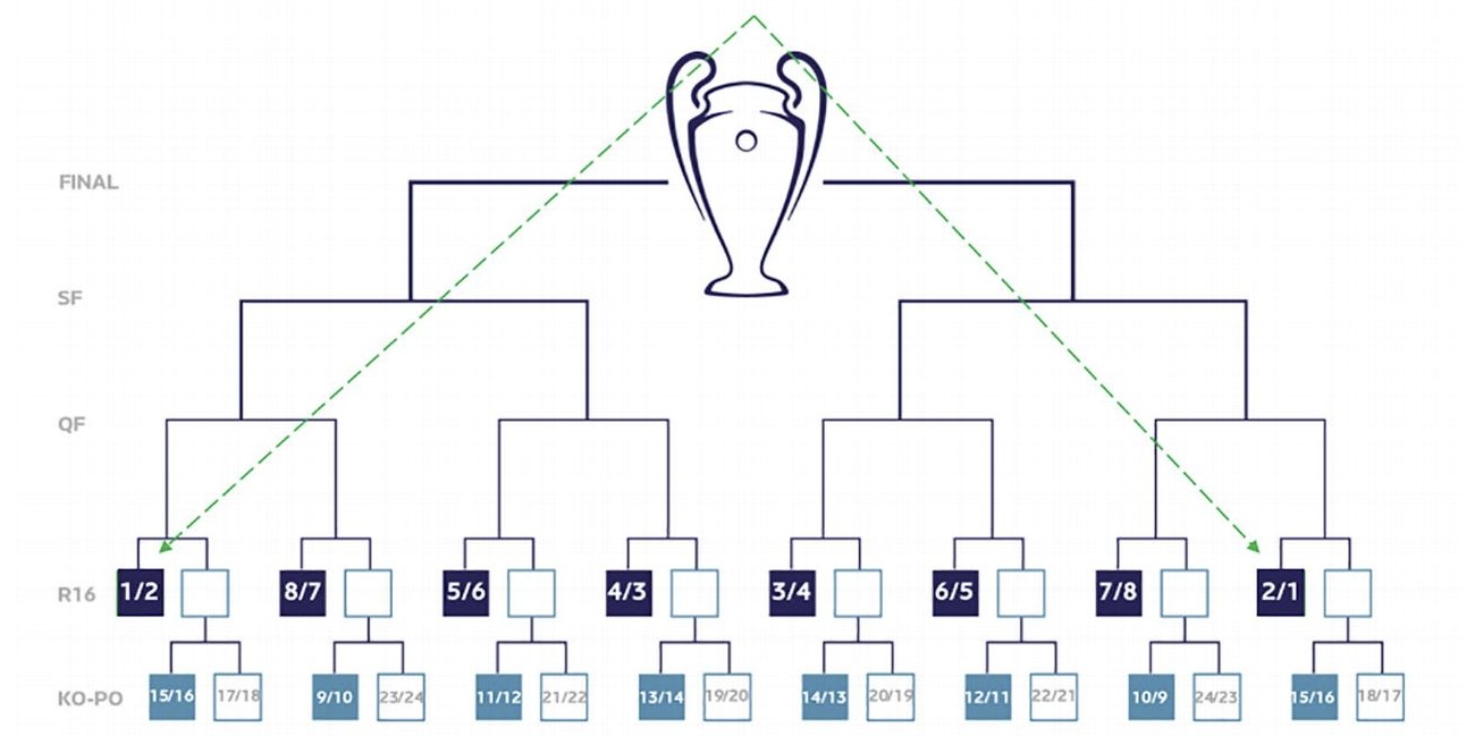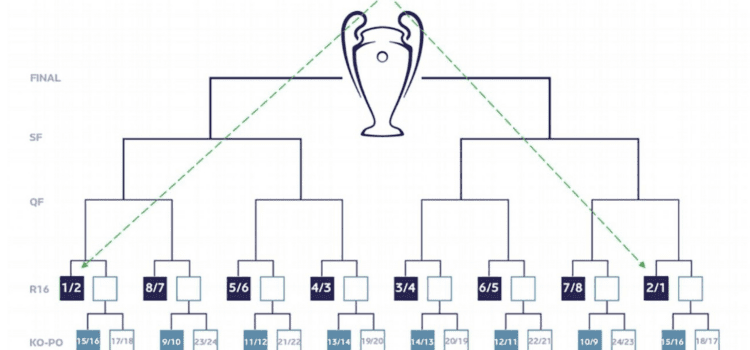The Champions League will look completely different from next season. More excitement, more top matches, more money. And every match, every point and every goal counts towards the competition, UEFA promised in a promotional video at the beginning of March.
By Jordi Tomasowa
But what will actually change? From next season, not 32 teams, but 36 clubs will participate in the Champions League. There is also no longer a group stage of 8 groups with 4 teams. There will be one large ranking list with all 36 clubs.
After completing the current season, 29 of the 36 participants have already been announced. The final seven tickets will be competed for in the preliminary rounds. PSV and Feyenoord are already certain of qualification. If FC Twente manages to finally shake off AZ this Eredivisie season, it will have a chance of winning a coveted starting ticket via the route for non-champions. The number three of the Netherlands must survive two preliminary rounds to qualify for the main tournament.
Participants Champions League 2024/25
Champions League winner 2024
Europa League winner 2024
Spain (4 tickets)
Italy (4 tickets)
England (4 tickets)
Germany (4 tickets)
France (3 tickets)
Netherlands (2 tickets)
Champion Portugal
Champion Belgium
Champion Scotland
Champion Austria
7 tickets through preliminary rounds
2 tickets coefficient ranking
Swiss model
Instead of dividing teams into 8 groups of 4, as is currently the case, one large ranking will be used next season for all 36 clubs based on points and possibly goal difference.
It is based on the Swiss model, which has its origins in chess. Each team plays eight matches against eight different opponents in the main phase, because it is simply not possible to meet every team with such a high ranking twice.
To prevent teams from only meeting relatively strong or weak clubs, there will be a pot division. This draw determines who the opponents are. UEFA creates 4 pots of 9 teams. The winner of the Champions League is in pot 1, all other pots are filled based on the five-year club coefficient. In the main phase, each team will meet two teams from pots 1, 2, 3 and 4 to play a total of 8 matches. Clubs from the same country cannot yet meet here. The exception to the rule is made for the countries with 5 clubs in the billion dollar ball.
To make it concrete, we look at what the pot layout would have looked like in the 2023/24 season, based on the new format in which 36 teams had qualified.
Pot 1: Manchester City, Bayern Munich, Liverpool, Real Madrid, Paris Saint-Germain, Manchester United, Barcelona, Inter, Sevilla.
Pot 2: Borussia Dortmund, Atlético Madrid, RB Leipzig, Benfica, Napoli, FC Porto, Arsenal, Shakhtar Donetsk, Red Bull Salzburg.
Pot 3: Atalanta, Feyenoord, AC Milan, SC Braga, PSV Eindhoven, Lazio, Red Star Belgrade, FC Copenhagen, Young Boys.
Pot 4: Real Sociedad, Olympique Marseille, Galatasaray, Celtic, Molde FK, Newcastle United, Union Berlin, Royal Antwerp FC, RC Lens.
According to 'the Swiss model', after the draw for the main phase, PSV could have played eight games against Bayern Munich (home), Paris Saint-Germain (away), Napoli (home), Atlético Madrid (away), Braga (home), Red Star Belgrade (away), Marseille (home) and Celtic (away).
When are the matches played?
The main phase will be completed between September and January. It will be the first time that Champions League matches will be played in the first month of a calendar year. Numbers one to eight in this ranking qualify directly for the last sixteen. The other 8 tickets are distributed in the intermediate round, where numbers 9 and 24 come into action. Numbers 25 to 36 are disabled. Unlike previous seasons, these teams cannot enter the knockout phase of the Europa League. If you are eliminated as a club, your European season is over.
Spectacle on January 29
UEFA already promised it: every match, every point and every goal counts towards the competition. The climax will take place on January 29, when all 36 clubs will take action simultaneously. With 18 Champions League matches at the same time and a lot still to play, quite a spectacle can be expected. As written, only the first 8 teams qualify directly for the last 16. Numbers 9 and 24 hope to secure a spot in the eighth finals through the intermediate round.
The knockout phase draw will also be rescheduled
The new knockout system of the Champions League uses a bracket, a scheme that we see, for example, in major tennis tournaments. The higher you finish, the better the path to the final. In this way, the numbers one and two of the main phase may only meet in the final of the Champions League. With this element, UEFA wants to encourage clubs to give everything in the last matches of the main phase to finish as high as possible.
The diagram below makes a lot clear. For example, the club that finishes ninth or tenth in the main phase – and therefore has to take action during the intermediate round – can only meet number 23 or 24. The draw for the knockout phase will be drawn for two schedules: draw the number 9 against the number 23 in the left path, then the numbers 10 and numbers 24 will automatically meet in the right path.

© ESPN.
The 8 clubs that qualify directly for the round of 16 have slightly more options in terms of the opponents they can draw. For example, numbers 1 and 2 from the main phase can meet numbers 15, 16, 17 or 18, who have already taken action in the intermediate round. Clubs play 'normal' home and away matches until the final.
What about the Europa League and the Conference League?
Both the Europa League and the Conference League are also being overhauled. Both European club tournaments will have the same format as the Champions League and will expand to 36 clubs. Teams in the main phase of the Europa League also play 8 matches. In the Conference League there remain 6, meaning that the first part of that tournament will end in December.
PSV and Feyenoord cash registers are ringing
PSV can crown themselves national champions of the Netherlands with a draw against Sparta Rotterdam on Sunday and Feyenoord, as number two, is also assured of participation in the brand new edition of the billion dollar ball. Unlike in recent years, the numbers one and two in the Eredivisie qualify directly for the main tournament of the Champions League.
The starting premiums increase from 15.6 to 18.6 million euros, while a variable premium is also added. When determining this, consideration is given to, among other things, the club ranking of the participants over the last five and ten years. It is expected that Feyenoord will collect 39 million euros in advance, excluding receipts and excluding all premiums that can be collected during matches, while PSV comes close to that with 37 million euros.
The premium per point will decrease (from nine to seven thousand). However, clubs get two extra matches to earn points. In addition, there are bonuses for the final score in the main phase.
More news
More sports news




![]()


